Panama
-
- Maritime History & the Panama Canal Maritime Reporter, Oct 2019 #26
The Panama Canal is a strategic crossroads for maritime traffic, and is arguably one of the most important maritime developments in the past century. Here we take a deeper dive into the history behind that famous strip of waterway.
The present canal, which saw its first vessel transits in 1914, along with possible alternatives through Nicaragua and Mexico, had actually been on the minds of merchants, explorers and military/political strategists since the Age of Exploration in early 1500’s. The precursor to the actual Canal was a railway across the Isthmus, conceived in the 1830s but actually built in the 1850s; the impetus for its construction, and an important attraction to its financial backers, was the California Gold Rush of the late 1840s.Shares in the Pacific Mail Steamship Company (benefiting from U.S. government contracts) flourished. The stock price for railroad and mail steamer shares boomed. The year 1869 was a pivotal year, events elsewhere loomed large. In North America, the trans-Continental Railroad was completed that year, which drastically cut into cross-Panama rail traffic (prompting a collapse of the railroad’s stock price). Nearly half a world away, the Suez Canal, linking the Mediterranean with the Indian Ocean, was completed, reviving thoughts of a canal linking the Atlantic and Pacific. Coming off their successes in Egypt with a sea level canal, the French canal builders tried a similar design in Panama, which was then a part of Colombia.
With more difficult topography (with the Continental Divide) and the tropical conditions (giving rise to disease), the investor backed French effort failed. The United States, a burgeoning power, picked up the pieces starting in the 1880s; eventually buying out the French company (which had acquired the defunct railroad along the way). After the Spanish American war of 1898 (and lengthy voyages around Cape Horn for U.S. naval vessels stationed in California), geopolitical considerations dominated the landscape. Panama broke free from Colombia (with some American help) in 1903. When the dust settled, the U.S. controlled a 10-mile swatch of territory across the Isthmus, i.e. the Canal Zone. Military considerations influenced the design of the original canal. The Panama Canal Authority’s history of the pre-construction phase notes: “At the request of the U.S. Navy, locks chambers were enlarged from 95 to 110 feet to accommodate vessels then on the drawing board.”
Concerns about Canal security, and redundancy in the event of military activity, drove an effort at Canal expansion, in the early 1940s, with dredging actually begun on a third set of locks suitable for battleships on the drawing board (but never actually built). This work, subsequently abandoned in 1942 (with World War II underway), was not in vain; it provided a head start on dredging at the new Pacific locks.
The U.S. merchant marine flourished in parallel with the U.S. expansive military might, climaxing in the late 1940s and into the 1950s, years predating the rise of intermodalism and the U.S. highway network- both of which began to take shape in the mid-1950s. Imports of steel from Asia and Europe were in nascent stages. Long gone names Isthmian Lines (established by then powerhouse U.S. Steel prior to the Canal’s opening) later amalgamated with States Marine regularly transported steel from the East Coast mills through the Canal, returning with general cargo, or with nitrates. Calmar Steamship, formed by competitor Bethlehem Steel, in response to Isthmian’s freight cost advantages, and Lykes Lines took steel outbound, and lumber from the Pacific Northwest, back to ports in the Gulf and Atlantic. Transits by other well known, but long gone, U.S. carriers including Grace Line, Great White Fleet, Farrell Lines (also with ties, originally, to U.S. Steel) and Pacific Panama Line, were commonplace.
In 1979, the U.S. and Panama agreed that the Canal Zone would be handed over to Panama at the end of 1999. For the maritime business, the trends towards larger vessels meant that major trades were bypassing Panama; with then maximum dimensions for vessels of approximately 960 x 105 ft. with a 39 ft. draft.
 Inaugural LNG transit, “MARAN GAS APOLLONIA” (July 2016). Courtesy of the Panama Canal Authority.
Inaugural LNG transit, “MARAN GAS APOLLONIA” (July 2016). Courtesy of the Panama Canal Authority.In 2007, after much study and a nationwide vote, Panama decided to go ahead with the massive expansion project, and vessels with dimensions of 1,200 x 161 ft. with a 49 ft. draft are now able to transit utilizing newly constructed locks and widened entrances on the Atlantic and Pacific sides. As a result both the containership and LNG trades have enjoyed dramatic, positive impacts.
With the expanded Canal finally opened in 2016. Drewry, a leading maritime consultant, wrote at the time, “The new set of locks at the Panama Canal opened for business on 26 June and it was the fittingly renamed Cosco Shipping Panama (9,472 teu) that won the draw to be the first ship through the widened canal, sailing westwards. Five days later, in the opposite direction and reportedly paying a toll fee of some $830,000, the 10,000 TEU MOL Benefactor was the first neo-Panamax unit to perform a commercial transit through the canal enroute for a berth slot at New York on 8 July, where she would become the largest containership the port has been asked to handle in its history.”
Drewry added, in the same report, “Without doubt, the ability of the canal to handle much larger ships is a groundbreaking event and heralds a new era in which a large swathe of US importers will have a much wider choice of options routing goods from the Far East. However, it will not all change overnight – the migration of seaborne cargo from the West Coast to the East Coast will continue to be a steady evolution.” The consultants also pointed to shifts in Liner alliances’ routing dynamics, commenting that: “New alliance service networks for Asia- ECNA favour the Panama Canal routing ahead of the Suez Canal.”
The Canal widening coincided with sea changes in LNG moves; with the first U.S. LNG exports moving out of Sabine Pass in early 2016. By 2019, multiple export facilities had already come online, with additional LNG trains to follow. U.S. Department of Energy data reveals exports of 840 cargoes through June 2019, with top recipients including South Korea (#1, with 144 cargos), Japan (#3 with 74 cargos), China (#4 with 65 cargos) and Chile (#5 with 46 cargos). When smaller off-takers are considered, more than 40% of U.S. LNG export liftings were to Pacific Rim receivers.
The new locks have had little impact on conventional dry bulk and tanker trades. On the dry side, larger Capesize vessels, laden with Brazilian ore, are too deep to transit the Canal. Brokers at Poten & Partners, writing in a mid-2018 Tanker Opinion piece (two years after the expansion), said that “So far, crude oil tankers make up only 3% of the total transits.” Many of these have movements have been repositioning voyages, as Poten explained that “… more than half of the transits were for oil tankers travelling in ballast…” typically after discharging on the U.S. West Coast and moving towards Caribbean load ports. The Canal has not been a factor in the burgeoning U.S. crude oil export trades (which began in late 2015); these move on Very Large Crude Carriers (VLCCs), like the big ore carriers, they are far too big for the Canal.IMO2020, impacting all aspects of shipping, has the potential to bring about a backslide in the East Coast’s traffic gains. Joshua Hurwitz, Senior Consultant at port designer firm Moffaft & Nichol has made the case that increased fuel costs due to IMO2020 could prompt 1.2 million TEUs inbound to the U.S. to swing back to West Coast discharge, with shorter transit times from Asian ports.
Trans-shipment terminals on both the Atlantic and Pacific sides have grown into mega cargo handlers; Hutchinson Whampoa, through its Panama Ports Company (both sides) and SSA Marine (Atlantic side), are leading terminal operators. Trans-shipments along the coasts were 7 million TEUs in 2017, according to Georgia Tech Panama Logistic Innovation and Research Center. The railroad across the Isthmus, which had been effectively abandoned, has been rekindled, part of a “Logistics Platform” (as termed by the eminent geography professor Jean-Paul Rodrigue) as a link for trans-shipping containers between Colon (on the Atlantic side) and Balboa (on the Pacific).
In 1998, just prior to the handover of the Canal to the Panamanians, the U.S. based Kansas City Southern railroad (NYSE- “KSU”) along with Mi-Jack, a leading producer of rubber tired gantry cranes (RTGs) and provider of intermodal terminal services to the major railroads ( through what is now called ITS Conglobal ), was granted a 50 year concession to operate the railroad, following an investment of $80 million. Railroad container traffic across the Isthmus, a closely guarded number, was reported to be 400,000 TEUs in 2014.
Panama Canal Authority, now deriving a large proportion of its toll revenues from the container trades ($2.5 billion total in 2018, of which 159 mm out of total 441 mm Panama Canal Universal Measurement System or PC/UMS tons, were from container vessels), has seen economics and change with the times. In 1965, in the already waning glory days of its merchant marine, U.S. flagged vessels transits numbered 1678; decades later, 126 U.S. registered vessels made the transit in 2018. But old patterns linger. In early 2017, the first tug barge transit through the widened Canal saw New Orleans-based Tradewinds Towing’s tug Hollywood pulling a beamy barge westbound from the Gulf of Mexico to the U.S. West Coast.
Any look at history always begs the question of what’s ahead. The ACP told Maritime Reporter & Engineering News that “The Panama Canal, always considering the competitiveness of the waterway, included the possibility of a Fourth Set of Locks in designing the Third Set of Locks, should additional access later be required due to demand from the global maritime industry to grow further. If this need does arise, the Panama Canal will conduct in-depth analyses of current and future demand, as well as water sources. Currently, the Panama Canal has no immediate plans to execute a fourth set of locks.”
-
- IHI Delivers 269,800-DWT Texaco Caribbean Maritime Reporter, May 15, 1977 #11
The Texaco Caribbean, a very large crude carrier (VLCC) of 269,800 deadweight tons, built for the fleet of Texaco Panama Inc. by IHI (Ishikawajima-Harima Heavy Industries Co., Ltd.), was christened recently in ceremonies at the IHI shipyard in Kure, Japan. The vessel was delivered last month and
-
- Thunderbolt Marine Industries Launches Twin 96-Foot Tugs For Panama Canal Services Maritime Reporter, Jul 15, 1977 #17
Marine Industries, Thunderbolt, Ga. They are the first of a new generation of shiphandling and firefighting tugs specifically designed for work in the Panama Canal. The main feature of these tugboats is the capability of the propellers, located just forward of amidship, to be rotated 360 degrees, enabling th
-
- $81 -Million Tanker American Spirit To Transport Oil From Alaskan Pipeline To Panama Canal Maritime Reporter, Aug 1977 #10
of 1977. The supertanker will leave immediately for the U.S. West Coast to go into service between Port Valdez, Alaska, and offshore of the Panama Canal west coast. She will transport crude oil from the Alaskan pipeline for transfer to smaller vessels at the Canal for shipment to Gulf Coast
-
- Panama Canal: The Billion Dollar Challenge Maritime Reporter, Aug 2014 #12
Panama Canal expansion will cost operators, insurers As the Panama Canal prepares to celebrate its 100th anniversary, insurers are warning of the increased risks that will arise from the plan to double the cargo-carrying capacity of the world’s most famous canal. In a report entitled Panama Canal 100:
-
- Dravo SteelShip Delivers Pilot Boats For Panama Canal Maritime Reporter, Nov 15, 1980 #12
Dravo SteelShip Corporation has announced the recent completion and delivery of nine 48-foot pilot boats for the Panama Canal Commission. The single-screw pilot launches have all been delivered to the Canal Zone under their own power. They were delivered two at a time for safety measures. The 2
-
- Solutions in Panama Maritime Reporter, Oct 2003 #38
it became a major problem. Hydrex was called upon to carry out the work, and immediately it dispatched a diving team to the vessel's location in Panama. The first call was to a local company where an appropriate sized mobdock was constructed to cover the area over the hull that needed replacement
-
- Northville To Engineer Pacific Deepwater Port For Panama Government Maritime Reporter, Mar 15, 1977 #34
Northville Industries of Huntington Station, N.Y., has announced the receipt of a contract with the government of Panama to conduct the first stage of a crude oil supertanker transshipment terminal on the Pacific Coast. The award authorizes Northville Industries to proceed with a feasibility study
-
- Schepen Appointed VP, Central America/Panama Service For Crowley Maritime Reporter, Apr 1991 #77
Rinus Schepen has been appointed vice president, Central America and Panama Service, for Crowley Maritime Corporation's Atlantic Division. He reports to Miguel A. Rossy, senior vice president- Crowley Caribbean Transport (CCT) Services. In his new position, Mr. Schepen, who is now headquartered
-
- Panama Canal Installs Marine Fendering System From Solidur Plastics Maritime Reporter, Mar 1991 #70
Solidur Plastics Co., Delmont, Pa., supplied an Ultra-High Molecular Weight Polyethylene (UHMWPE) marine fender system for the locks at the Panama Canal to protect oceangoing ships from the damaging impacts of bumping into the lockwalls. Jorge Quijano, chief of the Locks Division, Panama
-
- Moss Point Marine Completes Tug For Panama Canal Commission Maritime Reporter, Aug 1986 #50
Moss Point Marine, Inc., Escatawpa, Miss., has completed the all-steel, 105-foot harbor tug, Paz, to the Panama Canal Commission, Republic of Panama. Original construction was begun by another shipyard which did not complete the vessel due to inclement weather and a decision by its management to
-
- NABRICO Constructs 2 Dump Scows For Panama Canal Commission Maritime Reporter, May 1986 #63
Two 215-foot by 50-foot by 14- foot split-hull dump scows have been constructed by Nashville Bridge Company (NABRICO) of Nashville, Tenn., for the Panama Canal Commission. The two 1,300-cubic-yard barges, the first to be built by NABRICO for the Commission, will be used in the on-going dredging
-
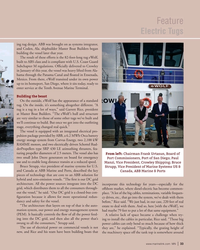 )
April 2024 - Marine News page: 33
)
April 2024 - Marine News page: 33.S. Coast Guard Subchapter M regulations. Of? cially delivered to Crowley in January of this year, the vessel was heavy lifted from Ala- bama through the Panama Canal and ? oated in Ensenada, Mexico. From there, eWolf transited under its own power up to its homeport, San Diego, where it sits today, ready
-
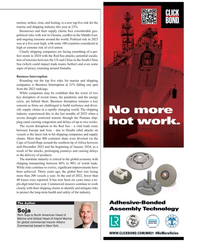 )
February 2024 - Maritime Reporter and Engineering News page: 13
)
February 2024 - Maritime Reporter and Engineering News page: 13in a rapidly changing world. The shipping industry experienced this in the last months of 2023 when a severe drought restricted transits through the Panama ship- ping canal causing congestion and delays of up to two weeks. The recent disruption in the Red Sea – a vital trade route between Europe and Asia
-
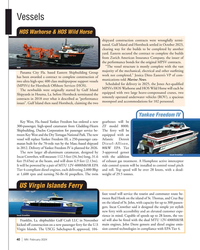 )
February 2024 - Marine News page: 40
)
February 2024 - Marine News page: 40Insurance Company, the issuer of the performance bonds for the original MPSV contracts. “The vessel structure is mostly complete with the vast HOS Panama City Fla. based Eastern Shipbuilding Group majority of the mechanical, electrical and other out? tting has been awarded a contract to complete constructi
-
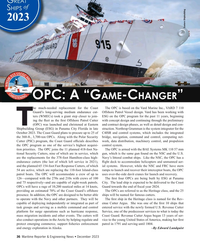 )
December 2023 - Maritime Reporter and Engineering News page: 36
)
December 2023 - Maritime Reporter and Engineering News page: 36the preliminary T(OPC) was launched and christened at Eastern and contract design phases, as well as detail design and con- Shipbuilding Group (ESG) in Panama City Florida in late struction. Northrop Grumman is the system integrator for the October 2023. The Coast Guard plans to procure up to 25 of C4ISR
-
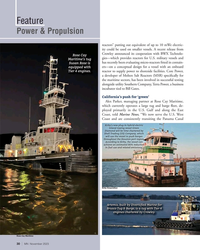 )
November 2023 - Marine News page: 30
)
November 2023 - Marine News page: 30, de- ployed primarily in the U.S. Gulf and along the East Coast, told Marine News, “We now serve the U.S. West Coast and are consistently transiting the Panama Canal Kirby’s new plug-in hybrid electric inland towing vessel Green Diamond will be time chartered by Shell Trading (US) Company, which will
-
 )
November 2023 - Maritime Reporter and Engineering News page: 80
)
November 2023 - Maritime Reporter and Engineering News page: 80. . . . . . . . . . . . . . . . . . . . .www.omnithruster.com . . . . . . . . . . . . . . . . . . . . . . . . . . . . . . . . . .(330) 963-6310 18 . . . . .Panama Maritime Authority . . . . . . . . . . . . . . . . . . . . . . . . . . .www.panamashipregistry.com . . . . . . . . . . . . . . . . . . . . . . .
-
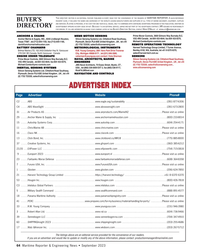 )
September 2023 - Maritime Reporter and Engineering News page: 64
)
September 2023 - Maritime Reporter and Engineering News page: 64. . . . . . . . . . . . . . . . . . . . . . .www.sealiftcommand.com . . . . . . . . . . . . . . . . . . . . . . . . . . . . . . .(888) 891-4577 18 . . . . .Panama Maritime Authority . . . . . . . . . . . . . . . . . . . . . . . . . . .www.panamashipregistry.com . . . . . . . . . . . . . . . . . . . . . . .
-
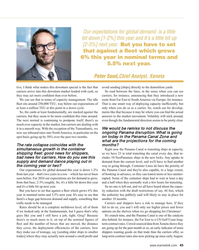 )
September 2023 - Maritime Reporter and Engineering News page: 45
)
September 2023 - Maritime Reporter and Engineering News page: 45the market, but carriers are dealing with it in a smooth way. With the exception of the Transatlantic, we We would be remiss to not discuss the ongoing Panama disruption. What is going now see inbound rates into North America, in particular on the on today in the Panama Canal Zone and spot basis going
-
![MR Sep-23#44 is a] water shortage in the Panama
Transatlantic route are](https://images.marinelink.com/images/magazines/w200h250c/MaritimeReporter-202309-page46.png) )
September 2023 - Maritime Reporter and Engineering News page: 44
)
September 2023 - Maritime Reporter and Engineering News page: 44the problems during the Covid years a vengeance. Carriers operating only in the spot market on the [and on top of that there is a] water shortage in the Panama Transatlantic route are bleeding, as they ? nd spot [rates lower Canal. But if we put the entirety of the market into perspec- 44 Maritime Reporter
-
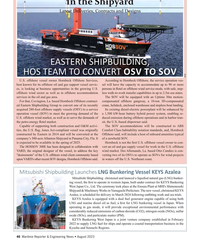 )
August 2023 - Maritime Reporter and Engineering News page: 46
)
August 2023 - Maritime Reporter and Engineering News page: 46by Eastern in 2014 and will be converted at the Offshore said, will include a host of onboard amenities typical company’s 300-acre Allanton Shipyard in Panama City, Fla. It of a newbuild SOV. is expected to be available in the spring of 2025. Hornbeck is not the ? rst U.S. offshore vessel owner to con- The
-
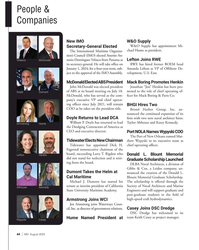 )
August 2023 - Marine News page: 44
)
August 2023 - Marine News page: 44Elected chael Hume as president. The International Maritime Organiza- tion’s Council (IMO) elected Arsenio An- tonio Dominguez Velasco from Panama as Lefton Joins RWE Velasco McDonald its secretary-general. He will take of? ce on RWE has hired former BOEM head January 1, 2024, for a four-year
-
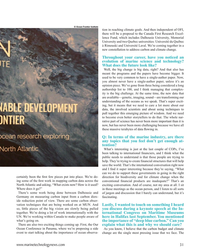 )
March 2023 - Marine Technology Reporter page: 31
)
March 2023 - Marine Technology Reporter page: 31“deep blue carbon.” Can you There are also two exciting things coming up. First, the Our explain what this is and why we should care? Ocean Conference in Panama, where we’re proposing a side As you know, I believe that the carbon budget and climate event to start talking about the importance of ocean observa-
-
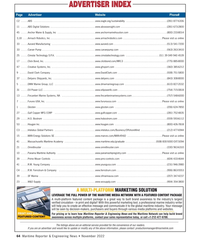 )
November 2022 - Maritime Reporter and Engineering News page: 64
)
November 2022 - Maritime Reporter and Engineering News page: 64. . . . . . . . . . . . . . . . . . . . .www.omnithruster.com . . . . . . . . . . . . . . . . . . . . . . . . . . . . . . . . . .(330) 963-6310 10 . . . . .Panama Maritime Authority . . . . . . . . . . . . . . . . . . . . . . . . . . .www.panamashipregistry.com . . . . . . . . . . . . . . . . . . . . . . .
-
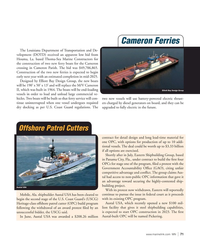 )
November 2022 - Marine News page: 71
)
November 2022 - Marine News page: 71vessels. The deal could be worth up to $3.33 billion if all options are exercised. Shortly after in July, Eastern Shipbuilding Group, based in Panama City, Fla., under contract to build the ? rst four OPCs for stage one of the program, ? led a protest with the Government Accountability Of? ce (GAO)
-
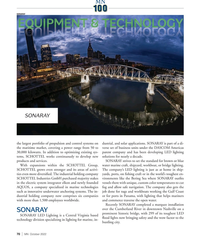 )
October 2022 - Marine News page: 70
)
October 2022 - Marine News page: 70anchoring systems. The in- job done for tugs and workboats working the Gulf Coast dustrial holding company now comprises six companies or for ports in Panama, with lighting that helps mariners with more than 1,500 employees worldwide. and commerce traverse the open water. Recently SONARAY completed a marquee
-
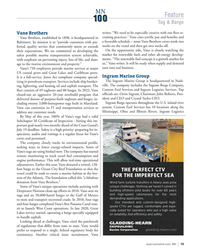 )
October 2022 - Marine News page: 19
)
October 2022 - Marine News page: 19and six 50,000-barrel barges to the Gulf of Mexico to store and transport recovered crude. In 2018, four tugs and four barges completed Vane’s ? rst Panama Canal tran- sit to launch West Coast operations. In late 2020, Great Lakes service started, operating a barge specially equipped to handle asphalt
-
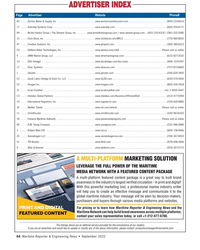 )
September 2022 - Maritime Reporter and Engineering News page: 64
)
September 2022 - Maritime Reporter and Engineering News page: 64. . . . . . . . . . . . . . . . . . . . .www.omnithruster.com . . . . . . . . . . . . . . . . . . . . . . . . . . . . . . . . . .(330) 963-6310 18 . . . . .Panama Maritime Authority . . . . . . . . . . . . . . . . . . . . . . . . . . .www.panamashipregistry.com . . . . . . . . . . . . . . . . . . . . . . .
-
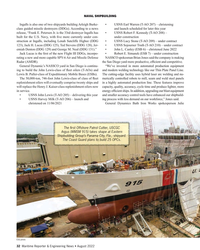 )
August 2022 - Maritime Reporter and Engineering News page: 32
)
August 2022 - Maritime Reporter and Engineering News page: 32General Dynamics Bath Iron Works spokesperson Julie The ? rst Offshore Patrol Cutter, USCGC Argus (WMSM 915) takes shape at Eastern Shipbuilding Group’s Panama City, Fla., shipyard. The Coast Guard plans to build 25 OPCs. ESG photo 32 Maritime Reporter & Engineering News • August 2022 MR #8 (18-33).indd
-
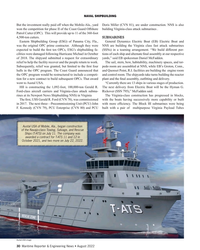 )
August 2022 - Maritime Reporter and Engineering News page: 30
)
August 2022 - Maritime Reporter and Engineering News page: 30attack submarines . Patrol Cutter (OPC). This will provide up to 11 of the 360-foot 4,500-ton cutters. SUBMARINES Eastern Shipbuilding Group (ESG) of Panama City, Fla., General Dynamics Electric Boat (EB) Electric Boat and was the original OPC prime contractor. Although they were NNS are building the
-
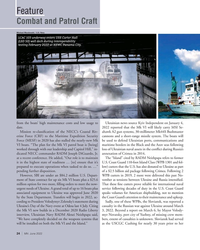 )
June 2022 - Marine News page: 24
)
June 2022 - Marine News page: 24Craft Michael Macdonald / U.S. Navy LCAC 103 underway enters USS Carter Hall (LSD 50) well deck during interoperability testing February 2022 at NSWC Panama City. from the boats’ high maintenance costs and low usage to Ukrainian news source Kyiv Independent on January 4, date. 2022 reported that the
-
 )
June 2022 - Marine News page: 23
)
June 2022 - Marine News page: 23Testing and successfully completed well deck interoper- ability trials. Tests were completed by PEO Ships and the Naval Surface Warfare Center (NSWC) Panama City Di- vision in Florida with the USS Carter Hall (LSD 50) on February 13, 2022. Captain Scot Searles, Amphibious Assault and Connec- tors Programs
-
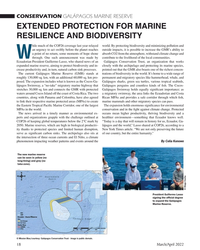 )
March 2022 - Marine Technology Reporter page: 18
)
March 2022 - Marine Technology Reporter page: 18; as waters around Cocos Island off the coast of Costa Rica. The two a migratory swimway, the area links the Ecuadorian and Costa countries, along with Panama and Colombia, have also agreed Rican MPAs and provides a safe corridor through which ? sh, to link their respective marine protected areas (MPAs)
-
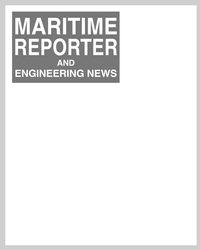 )
March 2022 - Maritime Reporter and Engineering News page: 18
)
March 2022 - Maritime Reporter and Engineering News page: 18; as waters around Cocos Island off the coast of Costa Rica. The two a migratory swimway, the area links the Ecuadorian and Costa countries, along with Panama and Colombia, have also agreed Rican MPAs and provides a safe corridor through which ? sh, to link their respective marine protected areas (MPAs)
-
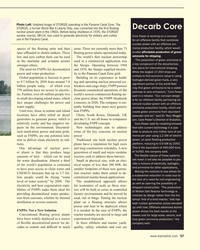 )
February 2022 - Maritime Reporter and Engineering News page: 57
)
February 2022 - Maritime Reporter and Engineering News page: 57Photo Left: Undated image of STURGIS operating in the Panama Canal Zone. The Decarb Core STURGIS, a former World War II Liberty Ship, was converted into the ? rst ? oating nuclear power plant in the 1960s. Before being shutdown in 1976, the STURGIS’ nuclear reactor, MH-1A, was used to generate electricity
